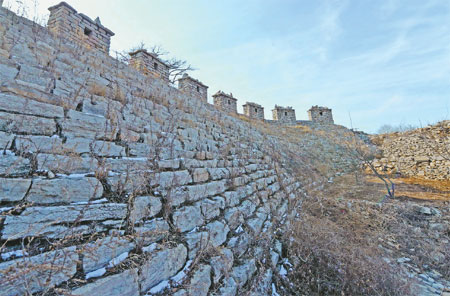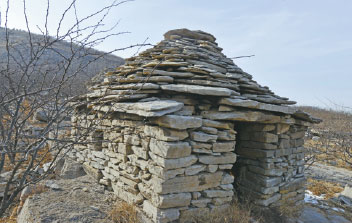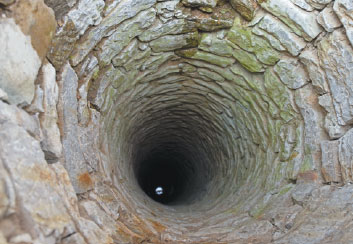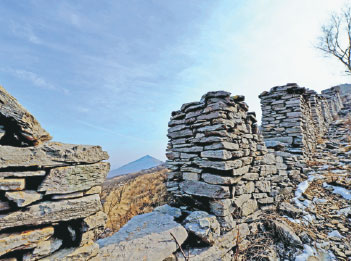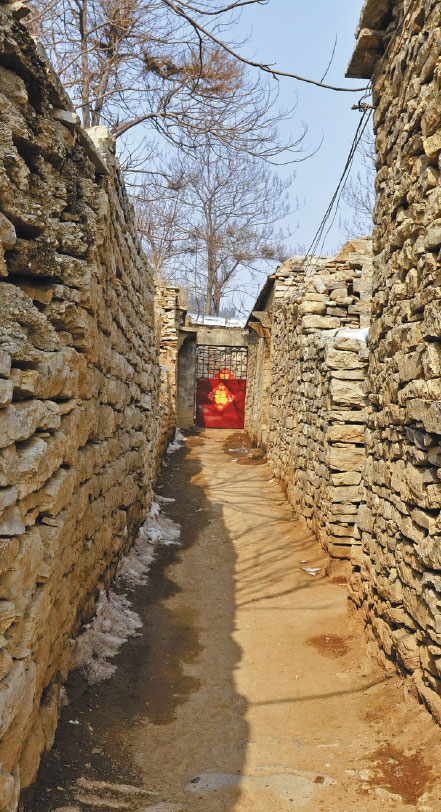Forgotten wall
Updated: 2014-03-20 07:29
By Zhao Ruixue (China Daily USA)
|
||||||||
It's an engineering feat from ancient times, but the wall constructed by the Qi State more than 2,500 years ago has been largely ignored. Zhao Ruixue chats to a man committed to exploring this slice of history.
Photographer Hu Deding, 63, never thought he would spend more than 10 years exploring an ancient engineering project seldom visited by tourists.
"I came across the ancient wall and found it so amazing. I just can't stop walking it and exploring it again and again," Hu says.
The wall Hu has been visiting was built by the Qi State in the Spring and Autumn Period (770-476 BC) and the Warring States Period (475-221 BC).
Investigations have shown that the Qi wall stretches across East China's Shandong province for 620 kilometers, from Jinan on the bank of the Yellow River to the coastal city of Qingdao in the east.
"When mentioning the long wall, people tend to think about the Great Wall built in the Qin Dynasty (221-206 BC) and in the Ming Dynasty (1368-1644). In my opinion, the Qi wall is no less important than the Great Wall of the Qin and Ming dynasties," Hu says.
Gary Feinman, curator of anthropology at the Field Museum in the United States, walked the easternmost 50 kilometers of the Qi wall.
"The Qi wall is a very important and impressive historical feature that miraculously still is visible across Shandong's landscape almost 2,500 years after it was built," Feinman says.
According to Fang Hui, head of the Institute of Cultural Heritage under Shandong University, the Qi wall is more than 300 years older than the more famous Great Wall first constructed by Emperor Qin Shihuang (260-210 BC).
Qin Shihuang, the first emperor of the Qin Dynasty, started building the Great Wall more than 2,000 years ago, which has become the world's largest man-made structure after it was expanded in the following dynasties. According to survey results released by the State Administration of Cultural Heritage in 2012, the Great Wall measures 21,196.18 kilometers in total.
The Qi wall was built to defend the Qi State against other competing states during the Spring and Autumn Period and the Warring States Period.
"The Qi wall divided warring states in China, while the Qin wall marked (Central) China's northern frontier," Feinman says.
During the Spring and Autumn Period and the Warring States Period, China was divided into smaller areas run by different states that expanded their territory by fighting their neighbors. More than 480 wars took place during that time. The leaders of each of the states built different types of fortifications to protect themselves.
The Qi State was a powerful state in those days and was under constant attack from the states of Lu, Jin and later, Chu, which originated from the middle reaches of the Yangzte River. As a result, the kings of the Qi State built walls to protect themselves.
Records of the Qi wall are first found in Zuo Zhuan (Chronicle of Zuo), one of the earliest Chinese works of narrative history. The book, which records history from 722 to 468 BC, is used by experts as an important source for understanding the history of the Spring and Autumn Period.
The book reveals that, in the year of 555 BC, the king of Qi used the wall as a defense and defeated an allied troop of 12 states at Guangli, a village that is now Xiaoli town of Changqing district in Shandong's provincial capital Jinan.
The Qin State was exterminated by Qin Shihuang in 221 BC.
In spite of various vicissitudes of history and the ravages of weather, the Qi wall has survived well. Passes, gates, castles, beacon towers and parapets have been found among the remains of the Qi wall. "One of the things that we learned by following the path of the Qi wall was how well engineered and planned this wall was," Feinman says.
"The section of the wall that we followed was built to avoid low areas as much as possible. It follows the topography and only descends when there were no other options."
The Qi wall takes advantage of mountains. Some parts of the wall use steep mountain cliffs as a natural fence.
Materials used in the construction of the wall are different. For the parts in areas that have abundant stones, the wall is built by piling up stones without using any binding agent.
The wall located at Laiwu city, which is 40 km away from Jinan, is made of stones and on barren mountains. It remains remarkably well preserved largely due to its remoteness. This 64.16-km-long section is 6 meters high at its highest point and about 2 meters wide.

Except the gate and the 50-meter-long section of the wall restored by the local government, the other part of the Laiwu section is original, allowing details of its engineering to be appreciated.
At the plain and valley areas, the wall is built with rammed earth like the eastern part of the wall.
"The wall must have required a great amount of labor to construct as most of the sediment for the wall had to be carried uphill to mountainous areas," Feinman says.
"Our archaeological settlement pattern studies indicate that the eastern section of the wall may have been built across what was a frontier zone (between the Shandong Peninsula and the coastal basin to the south) that was sparsely settled for about 1,000 years before the wall was built. After China was unified by Qin Shihuang, the area around the wall became more densely occupied by villages," Feinman says.
However, the Qi wall endured much damage and degradation from farming and modern development.
At the section in Changqing district in Jinan, Liu Bin, head of the cultural heritage office of Changqing district, says the wall was once 7 meters high, but now it is only 2 meters high. "Farmers take stones from the wall to build houses and banks of their farmland," Liu says. "Some sections of the wall have been removed to make room for roads."
Xie Zhixiu, head of the Shandong cultural heritage bureau, says that the Qi wall is deteriorating from natural erosion, construction, mining and land reclamation.
China approved a plan to preserve key sections of the Qi wall last year. Developed by the local authorities and approved by the central government, the plan gives priority to the preservation of 10 key sections and heritage sites.
"On the base of preservation, we will open some parts of the Qi wall to visitors and turn them into popular tourist sites like Badaling in Beijing," Xie says.
Contact the writer at zhaoruixue@chinadaily.com.cn.
|
Most parts of the Laiwu section of the Qi wall in Shandong province are original, allowing details of the wall's engineering to be appreciated. Phoots by Ju Chuanjiang / for China Daily |
|
A hut built by laying stones from the Qi wall is seen near the wall. |
|
An old well made of stones is found in Fangyu village at the foot of the Qi wall. |
|
The Qi wall was constructed more than 2,500 years ago. |
|
Most of the buildings in Fangyu village are made of stones. |
(China Daily USA 03/20/2014 page8)

 Fashions of the first ladies
Fashions of the first ladies
 Pro-Russian forces take over Ukraine's naval HQ
Pro-Russian forces take over Ukraine's naval HQ
 New US envoy hits ground running
New US envoy hits ground running
 HK cellist to perform at Carnegie Hall
HK cellist to perform at Carnegie Hall
 Skyscrapers in E China resemble LV check pattern
Skyscrapers in E China resemble LV check pattern
 President Xi honors memory of devoted county Party chief
President Xi honors memory of devoted county Party chief
 More than just food
More than just food
 Miss world visits cancer children in Colombia
Miss world visits cancer children in Colombia
Most Viewed
Editor's Picks

|

|

|

|

|

|
Today's Top News
Australia finds objects possibly from MH370
Tour adds 'new dimension' to ties
China largest holder of US debt
California shelves proposal
Chinese treasures on the block
China must expand inbound tourism
Hunger strike off, anger remains
Tourists offered compensation for bad air days
US Weekly

|

|
